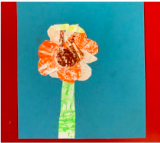Learning intention
- To understand how texture can be created and used to make art.
Success criteria
- I can create
This content is for subscribers only. Join for access today.
Cambridge Primary Art & Design (0067) Learning objectives
Cross-curricular links
None.
This content is for subscribers only. Join for access today.
Before the lesson
This content is for subscribers only. Join for access today.
Lesson plan
1: Lesson plan
An area for you to put useful resources from the previous lesson
This content is for subscribers only. Join for access today.
Differentiation
Learners needing support
May need help in identifying what a textured surface is and in holding the drawing tool correctly; should offer one to one support if needed as both tearing and cutting may be difficult for some pupils; should encourage them to create a simpler image or have some simple images they can copy.
Learners working at a stretch
Could encourage them to demonstrate how they create rubbings effectively to support others where needed; should encourage more detailed working of the selected rubbings into the composition.
This content is for subscribers only. Join for access today.
Assessing progress and understanding
Pupils with secure understanding indicated by: recognising suitable surfaces and
This content is for subscribers only. Join for access today.
Vocabulary definitions
-
cut
To use sharp tools such as scissors or knives.
-
frottage
The technique of taking a rubbing from textured surfaces to form the basis of a work of art.
This content is for subscribers only. Join for access today.
Example work


Walford Nursery and Primary School, Ross-on-Wye


Walford Nursery and Primary School, Ross-on-Wye


Walford Nursery and Primary School, Ross-on-Wye


Walford Nursery and Primary School, Ross-on-Wye


St Joseph's Primary School, Bracknell


St Joseph's Primary School, Bracknell


St Joseph's Primary School, Bracknell
This content is for subscribers only. Join for access today.
